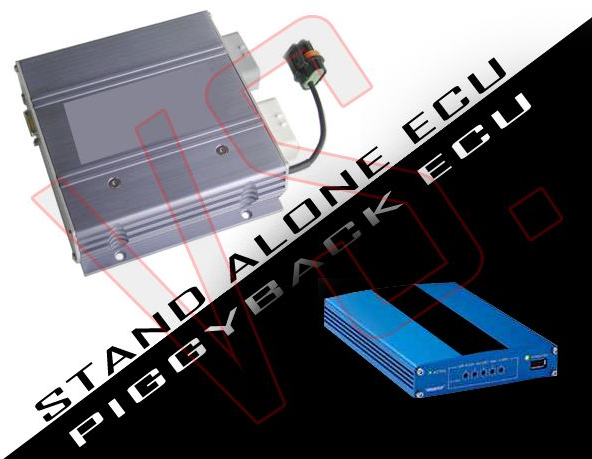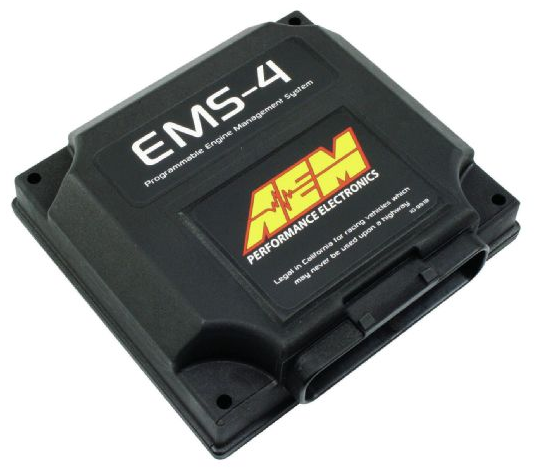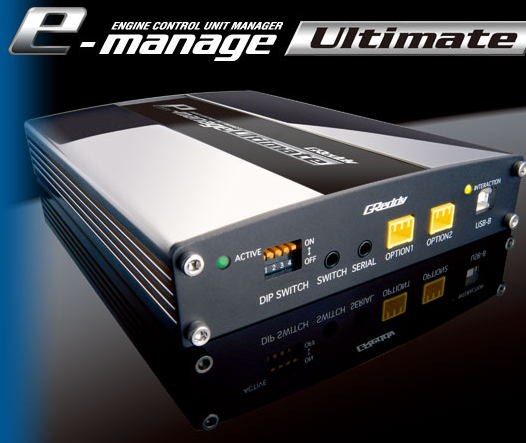| What's Hot! | Products/ Tools | EFI Tuning | Basic Tuning | Advanced Tuning | Chassis Tuning | Advertise with us |
Stand-alone Vs Piggyback ECU Set-ups

How each ECU set-up works and functions along with pro's and con's
Contributed By: Enginebasics.com
When it comes to modifying your vehicle for more power, eventually the time will come when you will need to tune your cars computer to match all of the modifications that you have added since the car was stock. While most people are happy with the factory computers control and would just like to adjust it for the new modifications they have added, that is not always an option. There are many manufactures who’s ECU’s are coded so that they cannot be tuned. The only way to access them is if a company has “cracked” the code and can then alter the tune. This isn’t always an option though. Now you are left with two choices.
1. Replace the factory Electronic Control Unit ( ECU ) with a full standalone ECU
2. Add another ECU to work with (piggyback) the stock ECU.
The purpose of this article is to talk about the differences of the two and also go over some pro’s and con’s of both set-ups.
Stand Alone ECU’s
A stand alone ECU is one that does just that…..stands alone. It completely replaces the factory ECU and “should” be able to control and do everything the factory ECU did plus much more depending on the aftermarket ECU you decide to install on your vehicle.
Pro’s of aftermarket ECU’s
1. Infinitely adjustable. Because the ECU is made to be tuned and modified, most companies in this market know that tuners what the ability to add, control, change things on the fly. This makes these ECU’s very versatile and able to handle all kinds of parameters and situations.
2. Able to be fine-tuned specifically for your engine. Every engine is slightly different no matter how much you match another cars build (blueprinting an engine). The ability to tune the engine specifically for your engine is a big plus.
3. Future mods can be added and tuned for, and there is no ceiling on the amount of power you can make and accommodate for.
Con’s of aftermarket CPU
1. If the vehicle is an OBD-II vehicle it will most likely no longer work with, and communicate with the OBD-II port. This means any gauges you have running out of that port will no longer function. Also the vehicle will not be able to pass emissions. Using it for diagnosis will no longer work as well so you will most likely lose the check engine light function at this time also.
2. Tuning. While it is the reason why you go with this option in the first place, it should also be listed in the CON section since this means you have to tune every parameter on the car. This is time consuming and will cost you money.
3. Compatibility with Sensors and Dash. Depending on how the factory ECU was configured, you may run into problems communicating with certain sensors and gauges on your dash. There are times where the temp gauge or tachometer doesn’t work when changing the ECU. Also the gauges that do work, will most likely have to have their parameters set up in the ECU. Again, more time and more tuning.
4. Cost. Stand alone ECU’s run anywhere from a grand to six and seven thousand dollars. OUCH!
Piggyback ECU
Before we dive right into to talking about the Pro’s and Con’s of this ECU, let’s talk about how some of them work first.
Piggyback ECU’s are wired to work with the factory ECU. Many times people ask: “Do I have a stand-alone or a piggy back?” We can answer that question really easily with another question. Is the factory ECU still in the car controlling some part of the motor? If the answer is Yes, than you have a piggyback.
There are two types of logics when it comes to piggy back ECU’s:
1. Intercept the signal from the sensors before the factory ECU, and modify those signals so the stock ECU is “tricked” into making the vehicle behave the way you want. For example, if you want the ECU to add more fueling, you would intercept the O2 sensor wire before the factory ECU “saw” that signal and modify it to make the ECU THINK that it is running lean causing the factory ECU to add fuel. Another method is to intercept the Maf sensor and tell the ECU there is more air going into the motor than there really is. Again, this would make the factory ECU compensate for the extra air coming in and add fueling.
2. The second method is POST ECU manipulation. Some piggy back ECU’s will modify the signal after it has left the stock ECU. Example. The piggy back will wire into the fuel injectors after the stock ECU so that you can add or take away fuel by either raising or lowering the injection time. This way the stock ECU is seeing all of the sensors information in real time but technically doesn’t have any control of the fueling that is ACTUALLY going to the fuel injectors.
Things can really get complicated when you realize that some signal wires have to be intercepted and modified before the ECU and some after the ECU. And some cars will work better using one method than the other. Figuring out the best set-up for your particular vehicle can be a never ending process. Hopefully you have a little understanding now of how a piggy back ECU works, so lets talk about the Pro’s and Con’s.
Pro’s of piggy back ECU’s:
1. Can be easier to set-up and tune. We will be putting this as a con as well because they can also be very difficult to set-up and tune depending on how hard the stock ECU fights you when you try and make adjustments or the wiring and manipulation you must do to get the factory ECU to do what you want.
2. Will retain OBD-II compliance. With the factory ECU in the vehicle functioning as it normally would, the car will still be able to communicate through the OBD-II port allowing you to pass emissions, scan for codes and problems, and use the port to run OBD-II gauges.
3. Cost. Piggy backs are usually a third if not a quarter of the cost of a full stand-alone ECU.
4. Full compliance with all sensors and gauges in the factory dash. With no modifications necessary to the factory ECU or sensors, everything will still work just as it normally would.
Con’s of Piggyback ECU
1. Tuning. Some factory ECU’s can be next to impossible to use a piggy back ECU on. No matter how you try and trick them into doing what you want, they are too adaptive or too sensitive. Many times you will get the map right where you want it, and the ECU will “learn” and change so that the perfect map you just had, is now a map ready to cause catastrophic engine failure. Other times the car will run great, but the ECU will know something is not right and pop the check engine light on you, making the vehicle not emissions compliant. The list could go on. While on paper the piggyback sounds like a great idea, the reality is it just doesn’t work for every vehicle platform.
2. Can only control so much. When you don’t have the ability to actually change the fueling or timing of a car, you can only manipulate what you’re working with so much. This is why you will often read about how a piggy back ECU can only tune up to 500cc injectors, or is only good for 400 HP on a given engine, or you are fine as long as you keep the boost under 18 psi. We’re just making up numbers there, but you get the idea. You are working inside the parameters of something that was set from the factory and it can only be “TRICKED” to work so much.
3. Wiring. Usually you are intercepting signal wires or ECU wires, and because of this you will have to cut and modify your factory engine harness. While this isn’t necessarily a bad thing, just remember that things change, and in the future you may want to bail that piggyback and move to a full stand-alone. Having a hacked up ECU harness could lead to a messy situation.
Some current pricing of the two most popular piggy back ECU's on the market:
Summary
So which one should you get. Well isn’t that the million dollar question. Answer is….who knows. You need to look at your exact goals with the car, is there a plug and play stand alone available, what is your budget, how much power do you want to make, do you need to stay emissions friendly…… you get the idea. Hopefully this article will give you the background knowledge to make a good informed decision.
ATTENTION READER:
If you enjoyed the information and article you just read be sure to check out our newly released book with even more exciting photo's and information:How to Turbocharge and Tune your Engine

Want to know more about your particular Make and Model vehicle? All of these vehicles are covered in the tech, maintenance and repair articles found above. Enginebasics is the wiki or wikipedia of car part, repair, how to and tuning information. Let us be the class 101 for your automotive learning.
| Ford | General Motors GM | Pontiac | Jaguar | Land Rover | Nissan |
| Toyota | Honda | Lexus | Acura | Lotus | Scion |
| Infinity | BMW | Mercedes | Mitsubishi | Ferrari | Maserati |
| Lamborghini | Volks Wagen VW | Saab | Audi | Hyundai | Kia |
| Subaru | Mazda | Chevy | Volvo | Caddilac | Dodge |
| Chrylser | Daewoo | Porsche | Mercury | Freightliner | MG |
Individual Models
| Ford Mustang | Mitsubishi Eclipse | Mitsubishi Evo | Subaru WRX / STI | Dodge Viper | Chevrolet Corvette |
| Nissan Skyline | Honda S2000 | Nissan 350z | Toyota Supra | Chevy Camaro | Lotus Elise Exige |
| Honda Civic | VW Golf | Dodge SRT-4 | Eagle Talon | Acura Integra | BMW M3 |
| Nissan 240sx | Porsche 911 | Acura NSX | Honda Accord | Toyota Camry | Toyota MR2 |
| VW R32 | Dodge Truck | Mazda Rx7 | VW Jetta | Sand Buggy | Nissan Sentra |
For the latest Automotive news and stories visit the websites below |
Our feature Build: An AWD V6 Civic






